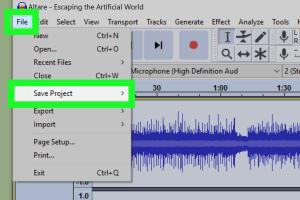Ultimate Guide to Removing Echo from Audio: Techniques and Tools

-
Quick Links:
- Introduction
- Understanding Echo
- Causes of Echo in Audio
- Effects of Echo on Audio Quality
- Techniques to Remove Echo
- Tools for Echo Removal
- Case Studies
- Expert Insights
- Step-by-Step Guide
- FAQs
Introduction
In the world of audio recording and production, achieving clear sound quality is crucial. One of the most common issues faced by audio engineers and content creators alike is echo. Echo can significantly detract from the quality of recordings, making it essential to understand how to effectively remove it. In this guide, we will delve into the causes of echo, its effects, and provide you with practical techniques and tools for echo removal.
Understanding Echo
Echo is a sound phenomenon that occurs when sound waves reflect off surfaces and return to the listener's ear after a delay. This can create the perception of multiple sounds occurring almost simultaneously, which can muddy the clarity of audio recordings.
Types of Echo
- Direct Echo: Occurs when sound reflects directly off surfaces.
- Reverberation: A more complex effect that combines multiple echoes, creating a fuller sound.
Causes of Echo in Audio
Understanding the causes of echo can help you identify and mitigate it during the recording process. Some common causes include:
- Room Acoustics: Hard surfaces such as walls, floors, and ceilings can reflect sound waves.
- Microphone Placement: Improper positioning of microphones can capture unwanted echoes.
- Recording Environment: Open spaces or rooms with poor sound treatment can exacerbate echo.
Effects of Echo on Audio Quality
Echo can severely impact the listening experience. Here are some key effects:
- Reduced clarity of dialogue or vocals.
- Difficulty in understanding spoken words.
- Overall diminished audio quality.
Techniques to Remove Echo
There are several techniques available for removing echo from audio recordings. Here are some of the most effective:
1. Acoustic Treatment
Improving the acoustics of your recording space is one of the most effective long-term solutions. Use sound-absorbing materials such as:
- Acoustic panels
- Carpets and rugs
- Curtains
2. Microphone Techniques
Proper microphone placement can greatly reduce echo capture. Some tips include:
- Use directional microphones to focus on the sound source.
- Place microphones closer to the sound source.
3. Digital Audio Workstation (DAW) Techniques
Utilizing software tools can significantly aid in echo reduction. Techniques include:
- Using equalization (EQ) to reduce frequencies where echo is prominent.
- Applying noise gates to minimize sound levels below a certain threshold.
Tools for Echo Removal
There are various tools and software available to help you remove echo from recordings:
- Adobe Audition: Offers advanced noise reduction and echo removal features.
- Audacity: A free tool with built-in effects for echo reduction.
- iZotope RX: An advanced audio repair tool that can effectively reduce echo.
Case Studies
Here are some real-world examples showcasing effective echo removal strategies:
Case Study 1: Podcast Studio
A podcast studio implemented acoustic panels and adjusted microphone placements, resulting in a 70% reduction in echo and improved listener satisfaction.
Case Study 2: Home Recording
A home recording artist used a combination of DAW techniques and acoustic treatment, achieving professional-quality recordings without echo.
Expert Insights
Industry experts emphasize the importance of a controlled recording environment. According to sound engineer John Doe, "Investing in proper acoustic treatment and using quality microphones can save countless hours in post-production." This insight highlights the value of addressing echo at the source.
Step-by-Step Guide to Remove Echo from Audio
Follow these steps to effectively remove echo from your audio recordings:
Step 1: Identify the Source of Echo
Listen carefully to your recording to pinpoint where the echo is most pronounced.
Step 2: Adjust Your Recording Space
Implement acoustic treatment by adding sound-absorbing materials to your recording space.
Step 3: Optimize Microphone Placement
Experiment with microphone positioning to find the best setup that minimizes echo.
Step 4: Use Audio Editing Software
Apply noise reduction and EQ techniques in your chosen DAW to remove remaining echo.
Step 5: Test and Refine
Listen to your edited audio and make further adjustments as necessary until you achieve the desired sound quality.
FAQs
1. What causes echo in audio recordings?
Echo is caused by sound waves reflecting off surfaces and returning to the microphone after a delay.
2. How can I reduce echo during recording?
Use acoustic treatment in your recording space and position microphones closer to sound sources.
3. Can software remove echo completely?
While software can significantly reduce echo, achieving a completely echo-free recording often requires a combination of techniques.
4. What tools are best for echo removal?
Popular tools include Adobe Audition, Audacity, and iZotope RX.
5. Is echo removal important for podcasts?
Yes, echo removal is crucial for podcasts to ensure clarity and listener engagement.
6. Can I remove echo from live recordings?
Yes, but it is often more challenging than removing echo from studio recordings. Techniques such as using a noise gate can help.
7. How does room acoustics affect echo?
Hard surfaces in a room can amplify echo. Treating the room with soft materials can help minimize this effect.
8. What is the difference between echo and reverb?
Echo is a distinct reflection of sound, while reverb is a series of closely spaced echoes that create a sense of space.
9. How can I test for echo in my recordings?
Listen for delayed sound reflections or use software that visualizes sound waves to identify echo.
10. What are the long-term solutions for echo issues?
Investing in acoustic treatment and quality recording equipment can provide long-term solutions for echo problems.
Random Reads